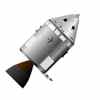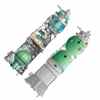
Home - Search - Browse - Alphabetic Index: 0- 1- 2- 3- 4- 5- 6- 7- 8- 9
A- B- C- D- E- F- G- H- I- J- K- L- M- N- O- P- Q- R- S- T- U- V- W- X- Y- Z
Lunar Orbiters
Manned lunar orbiters and orbiting stations were rarely designed for this purpose alone, but usually used in a lunar-orbit rendezvous lunar landing scenario together with a separate lunar lander. They were more powerful than circumlunar manned spacecraft in that they required substantial propellant to brake into and get out of lunar orbit.
For lunar base support, lunar orbiters made little sense unless the activities on the moon's surface were located either along the equator or near the poles (since otherwise the moon's slow rotation meant that the orbit would pass over the sites only twice a month).
Subtopics
 | Pioneer 0-1-2 American lunar orbiter. Pioneers 0, 1 and 2 were the first U. S. spacecraft to attempt to leave Earth orbit. |
 | Pioneer P 3 American lunar orbiter. The least successful lunar spacecraft; none even achieved orbit in four attempts. |
 | Apollo CSM The Apollo Command Service Module was the spacecraft developed by NASA in the 1960's as a standard spacecraft for earth and lunar orbit missions. Manned spacecraft for earth orbit and lunar orbit satellite operated by NASA, USA. Launched 1967 - 1975. |
| L4-1960 Russian manned lunar orbiter. Study 1960. Lunar orbiter proposed by Korolev in January 1960. The spacecraft was to take 2 to 3 men to lunar orbit and back to earth by 1965. |
 | Apollo D-2 American manned lunar orbiter. Study 1962. The General Electric design for Apollo put all systems and space not necessary for re-entry and recovery into a separate jettisonable 'mission module', joined to the re-entry vehicle by a hatch. |
 | L4-1963 Russian manned lunar orbiter. Study 1963. The L-4 Manned Lunar Orbiter Research Spacecraft would have taken two to three cosmonauts into lunar orbit for an extended survey and mapping mission. |
| Apollo MSS American manned lunar orbiter. Study 1965. The Apollo Mapping and Survey System was a kit of photographic equipment that was at one time part of the basic Apollo Block II configuration. |
| Gemini - Saturn V American manned lunar orbiter. In late 1964 McDonnell, in addition to a Saturn 1B-boosted circumlunar Gemini, McDonnell proposed a lunar-orbit version of Gemini to comprehensively scout the Apollo landing zones prior to the first Apollo missions. |
| Surveyor Orbiter American lunar orbiter. Study 1965. NASA originally planned to have a version of the Surveyor spacecraft conduct detailed orbital photographic reconnaissance of the moon in preparation for the Apollo manned landings. |
 | Gemini - Double Transtage American manned lunar orbiter. Study 1965. In June 1965 astronaut Pete Conrad conspired with the Martin and McDonnell corporations to advocate an early circumlunar flight using Gemini. |
 | Apollo Experiments Pallet American manned lunar orbiter. Study 1965. The Apollo Experiments Pallet was a sophisticated instrument payload that would have been installed in the Apollo CSM for dedicated lunar or earth orbital resource assessment missions. |
 | Luna E-6S Russian lunar orbiter. Lunar lander, Russia. Launched 1966. |
 | Lunar Orbiter American lunar orbiter. Photography of the moon's surface from selenocentric orbit. The Lunar Orbiter series took photos of lunar surface from selenocentric orbit. Lunar lander built by Boeing for NASA, USA. Launched 1966 - 1967. |
 | Luna E-6LF Russian lunar orbiter. Photographed lunar surface and orbital space environment in preparation for manned missions. Lunar lander, Russia. Launched 1966. |
 | Luna E-6LS Russian lunar orbiter. The E-6LS was a radio-equipped version of the E-6 used to test tracking and communications networks for the Soviet manned lunar program. Lunar lander, Russia. Launched 1967 - 1968. |
 | Gemini LORV American manned lunar orbiter. Study 1967. This version of Gemini was studied as a means of rescuing an Apollo CSM crew stranded in lunar orbit. The Gemini would be launched unmanned on a translunar trajectory by a Saturn V. |
 | Lunar Orbit OPS Russian manned lunar orbiter. In Chelomei's 1968 draft project for the UR-700, he proposed that versions of the Almaz OPS be placed in lunar orbit to conduct detailed reconnaissance of the surface using manned assistance. |
 | Soyuz 7K-L1A Russian manned lunar orbiter. Hybrid spacecraft used in N1 launch tests. |
| Apollo LRM American manned lunar orbiter. Study 1969. Grumman proposed to use the LM as a lunar reconnaissance module. But NASA had already considered this and many other possibilities (Apollo MSS, Apollo LMSS); and there was no budget available for any of them. |
 | Soyuz 7K-L1E Russian manned lunar orbiter. Modification of Soyuz circumlunar configuration used in propulsion tests of the Block D stage. Technology satellite, Russia. Launched 1969 - 1970. Used the Blok-D bus. |
 | OS-1 Lunar Russian manned lunar orbiter. Study 1969. A version of the OS-1 station was proposed for use in lunar orbit. No other details beyond this sketch. |
 | Skylab Lunar Orbit Station American manned lunar orbiter. Study 1970. McDonnell Douglas (Seal Beach, CA) did a study on modifying the to modify the Skylab as a moon-orbiting observatory and station |
 | Soyuz 7K-LOK Russian manned lunar orbiter. The two-crew LOK lunar orbiting spacecraft was the largest derivative of Soyuz developed. Manned Lunar orbit and return satellite, Russia. Launched 1972. |
 | PFS American lunar orbiter. Released from Apollo; particles and fields experiments. Lunar Orbit (Selenocentric). Lunar lander built by TRW for NASA, USA. Launched 1971 - 1972. |
 | Luna Ye-8-LS Russian lunar orbiter. Lunar surface mapping. Lunar lander, Russia. Launched 1971 - 1974. |
 | Lunar Orbit Station American manned lunar orbiter. Study 1984. A variety of lunar orbital way-stations, based on space station components, were studied by NASA in the 1980's. |
 | LOK Energia Russian manned lunar orbiter. Study 1988. Lunar orbiter for Energia-launched lunar expedition. The LOK and LK lander would be inserted into lunar orbit by separate Energia launches. |
 | Hagoromo Japanese lunar orbiter. Lunar orbiter ejected from Muses A 3/19/90; contact lost after release; engineering test. Lunar Orbit (Selenocentric). |
 | Hiten Japanese lunar orbiter. MUSES-A was renamed Hiten after launch. It developed of lunar swing-by techniques for future missions and ejected a lunar orbiter. |
 | Clementine American lunar orbiter. Clementine was jointly sponsored by BMDO and NASA as the Deep Space Program Science Experiment (DSPSE). Lunar orbiter, asteroid flyby, technology experiments satellite built by Naval Research Laboratory (NRL) for BMDO, USA. Launched 1994. |
 | Lunar Prospector American lunar orbiter. Lunar lander built by Lockheed Martin for NASA, USA. Launched 1998. Used the LM-100 bus. |
 | SMART-1 European lunar orbiter. Insat 3E. ESA's SMART-1 was to test miniaturization technology while exploring the Moon from orbit. Lunar orbiter, Technology Experiments satellite built by Swedish Space Corporation (SSC) for ESA, Europe. Launched 2003. |
 | Kaguya Japanese lunar orbiter. Launched 2007.09.14. |
 | Chang'e Chinese unmanned lunar orbiter. Originally announced in March 2003 with the first spacecraft to reach the moon by the end of 2005. Lunar lander and rover satellite built by CAST, China. Launched 2013. |
 | Chandraayan Indian lunar orbiter. First Indian lunar orbiter. It released the MIP impactor. Lunar lander operated by ISRO, India. Launched 2008. |
Back to top of page
Home - Search - Browse - Alphabetic Index: 0- 1- 2- 3- 4- 5- 6- 7- 8- 9
A- B- C- D- E- F- G- H- I- J- K- L- M- N- O- P- Q- R- S- T- U- V- W- X- Y- Z
© 1997-2019 Mark Wade - Contact
© / Conditions for Use
